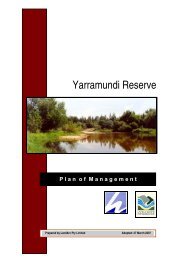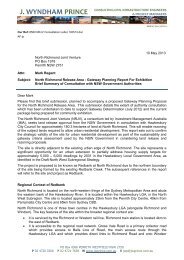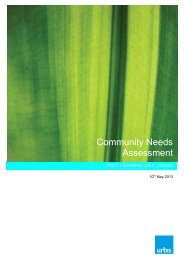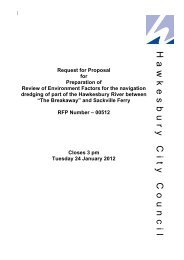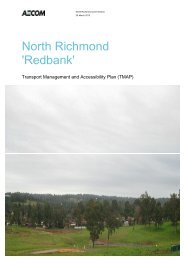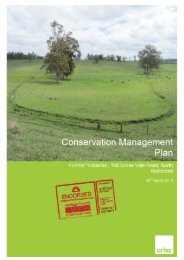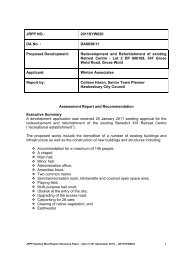Attachment 1 to Item 53 - Roadside Vegetation Management Plan
Attachment 1 to Item 53 - Roadside Vegetation Management Plan
Attachment 1 to Item 53 - Roadside Vegetation Management Plan
You also want an ePaper? Increase the reach of your titles
YUMPU automatically turns print PDFs into web optimized ePapers that Google loves.
H AW K E S B U R Y C IT Y C O U N C IL R O AD S ID E V E G E T AT IO N M AN AG E M E N T P L AN<br />
not compete. Weeds can also spread from roadsides <strong>to</strong> adjacent remnant bushland or agricultural land,<br />
which degrades natural environments and is a potential problem for agriculture.<br />
Weeds can be categorised according <strong>to</strong> the areas in which they occur and the type of threat they pose.<br />
Weed categories include noxious weeds, environmental weeds, agricultural weeds, and Weeds of<br />
National Significance (WoNS). Noxious weeds are plant species which are considered <strong>to</strong> be (or have<br />
the potential <strong>to</strong> become) a serious threat <strong>to</strong> primary production, Crown Land, the environment or<br />
community health, and can spread within an area and <strong>to</strong> other areas. Environmental weeds are plant<br />
species (native or introduced) that occur outside of their geographic range which can have a significant<br />
impact on native vegetation communities and flora and fauna species. Agricultural weeds are plant<br />
species that pose a threat <strong>to</strong> agricultural production. Weeds of National Significance are weeds that are<br />
considered <strong>to</strong> be the worst weed species in Australia because of their invasiveness, potential for<br />
spread, and economic and environmental impacts (NSW Department of Primary Industries website).<br />
Given that weeds pose a serious threat <strong>to</strong> vegetation communities and flora and fauna habitat, limiting<br />
the spread of weeds needs <strong>to</strong> be a priority in roadside vegetation management. Under the NW Act,<br />
HCC has an obligation <strong>to</strong> control the spread of noxious weeds in its management areas. However,<br />
there are no legislative requirements that bind HCC <strong>to</strong> control environmental weeds, some WoNS or<br />
agricultural weeds.<br />
It is recommended that the HCC provide a copy of this RVMP <strong>to</strong> all relevant Corporations authorised <strong>to</strong><br />
install and maintain utilities in roadsides <strong>to</strong> make them aware of the document and their role in<br />
preventing the spread of weeds and other plant pathogens along roadsides.<br />
3.7 PLANT PATHOGEN MAN AGEMENT<br />
Phy<strong>to</strong>phthora (Phy<strong>to</strong>phthora cinnamomi) is a serious fungal pathogen which has caused the destruction<br />
of many indigenous and exotic flora species. The fungus is soil-borne, and encysting (dormant) spores<br />
are readily transported in soil adhered <strong>to</strong> vehicles, particularly earth moving machinery. A typical<br />
symp<strong>to</strong>m of Phy<strong>to</strong>phthora is one of dieback of the upper branches as Phy<strong>to</strong>phthora destroys the<br />
structure of the root tissues, "rotting" the root, and preventing the plant from absorbing water and<br />
nutrients.<br />
When Phy<strong>to</strong>phthora dieback spreads <strong>to</strong> native plant communities, it kills many susceptible plants,<br />
resulting in a permanent decline in the biodiversity and a disruption of ecosystem processes. It can<br />
change the composition of a vegetation community by increasing the number of resistant plants and<br />
reducing the number of susceptible plant species. Native animals that rely on susceptible plants for<br />
survival are reduced in numbers or are eliminated from sites infested by Phy<strong>to</strong>phthora dieback.<br />
To date, dieback from Phy<strong>to</strong>phthora has not been a major problem in the Hawkesbury LGA. However,<br />
given that Phy<strong>to</strong>phthora is soil-borne pathogen, there is high potential for the fungus <strong>to</strong> be spread as a<br />
soil-borne contaminant on machinery, vehicles, or horse hooves. Once present, there is potential for<br />
further spread, particularly during wet periods as Phy<strong>to</strong>phthora is more readily dispersed in moist soil.<br />
The maintenance of clean machinery is the most effective method of preventing the introduction and<br />
spread of Phy<strong>to</strong>phthora from one area <strong>to</strong> another. There are no treatments available that can be used<br />
<strong>to</strong> treat Phy<strong>to</strong>phthora infestations; hence, preventing infestations becoming established is the best<br />
management action for this issue.<br />
© E C O L O G I C AL AU S T R AL I A P T Y L T D<br />
30



